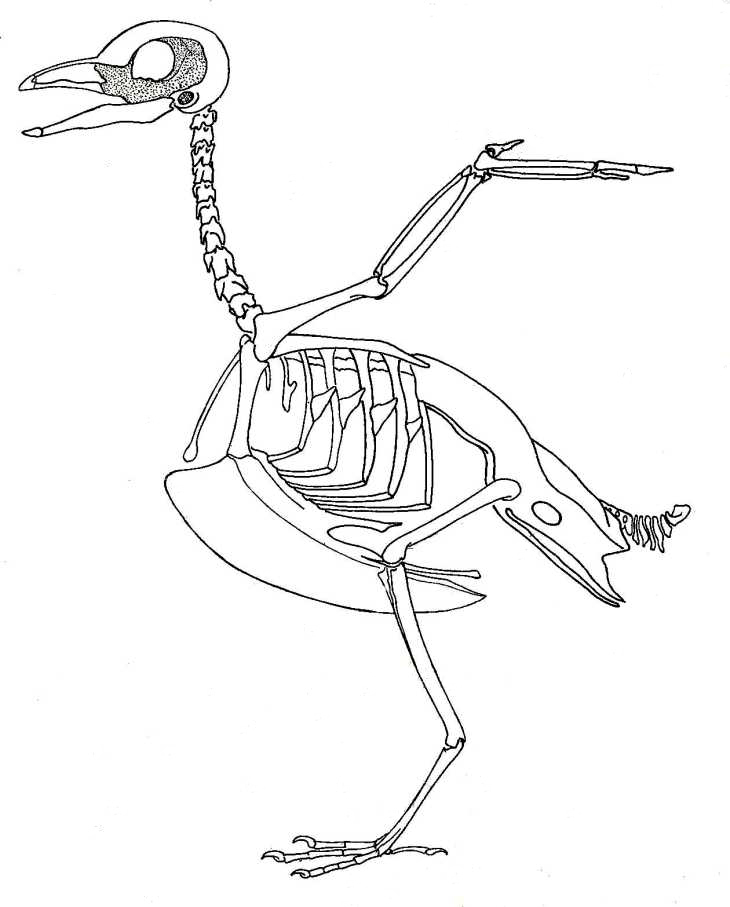Part 2: Dinosaur Groups
 Yes, modern birds are in the
lizard-hipped group, and not the bird-hipped group. I told you not to get too
attached to those concepts. Birds are an odd thing when it comes to their
placement with dinosaurs, and recently they have received some attention by
being placed in the Linnaean system as a group of dinosaurs (but there will be
an entire post about that topic). For the moment, forget where birds are in the
groups. If we look at a bird's hip bones, they do fit the shape shared by
ornithischian dinosaurs, which is why we call that order 'bird-hipped'. But
modern birds are not related to ornithischian dinosaurs, they instead, evolved
from the 'lizard-hipped' dinosaurs. So though, the pelvic structures of birds
and ornithischian dinosaurs are similar, they are not interrelated. Rather,
bird pelvises started out looking like saurischian dinosaurs, and the pubis
bone slowly moved back into a position against the ischium.
Yes, modern birds are in the
lizard-hipped group, and not the bird-hipped group. I told you not to get too
attached to those concepts. Birds are an odd thing when it comes to their
placement with dinosaurs, and recently they have received some attention by
being placed in the Linnaean system as a group of dinosaurs (but there will be
an entire post about that topic). For the moment, forget where birds are in the
groups. If we look at a bird's hip bones, they do fit the shape shared by
ornithischian dinosaurs, which is why we call that order 'bird-hipped'. But
modern birds are not related to ornithischian dinosaurs, they instead, evolved
from the 'lizard-hipped' dinosaurs. So though, the pelvic structures of birds
and ornithischian dinosaurs are similar, they are not interrelated. Rather,
bird pelvises started out looking like saurischian dinosaurs, and the pubis
bone slowly moved back into a position against the ischium.
Last time we talked about the
Linnaean classification system, and what it takes to qualify as a dinosaur.
Next, we expand on that idea by further dividing up our now defined group.
The
easiest way to look at dinosaurs as a broad group is to divide them into two
major orders, Ornithischia and Saurischia. How is your Greek? Not good?
Me too. Okay, these two orders are divided up based on hip
structures (see I bet you didn't know paleontology was so hip!).
Ornithischia comes from the Greek
words meaning 'bird' and 'hip-joint', while Saurischia means 'lizard'
'hip-joint'. Now don't get too attached to these meanings because I will throw
a wrench into the whole thing and make it far more complicated to remember. I
know, I hear you complaining that I just explained last time, that dinosaurs
are not lizards and that is mostly due to their unique hip-joint. Yes, that is
true. And saurischian dinosaurs are no exception. The name simply means they
have a more lizard-like pelvis than the ornithischians. They both still have a
dinosaur pelvis with the same three basic parts and the distinct acetabulum
(the fancy hip-socket). But as we look at the two types of hips together, we
can see they are arranged differently. Each consists of an illium,an ischium
(the part that gives us the 'ischia'
part of the name), and the pubis. But while the ornithischians' pubis sits back
against the ischium, pointing toward the tail of the creature, the
sauruschians' pubis bone juts forward, creating a triangular shape.
This gives us our two basic groups of
dinosaurs, bird-hips and lizard-hips. Now comes that wrench I was talking
about, and something we will get into far more detail about later. The
ornithischians are the smaller group when we look at body plan diversity. We
will talk about this group in the next installment. The saurischians, however,
are the most diverse. This group contains species varying from T. rex to
Brachiosaurus. It also contains birds.
 Yes, modern birds are in the
lizard-hipped group, and not the bird-hipped group. I told you not to get too
attached to those concepts. Birds are an odd thing when it comes to their
placement with dinosaurs, and recently they have received some attention by
being placed in the Linnaean system as a group of dinosaurs (but there will be
an entire post about that topic). For the moment, forget where birds are in the
groups. If we look at a bird's hip bones, they do fit the shape shared by
ornithischian dinosaurs, which is why we call that order 'bird-hipped'. But
modern birds are not related to ornithischian dinosaurs, they instead, evolved
from the 'lizard-hipped' dinosaurs. So though, the pelvic structures of birds
and ornithischian dinosaurs are similar, they are not interrelated. Rather,
bird pelvises started out looking like saurischian dinosaurs, and the pubis
bone slowly moved back into a position against the ischium.
Yes, modern birds are in the
lizard-hipped group, and not the bird-hipped group. I told you not to get too
attached to those concepts. Birds are an odd thing when it comes to their
placement with dinosaurs, and recently they have received some attention by
being placed in the Linnaean system as a group of dinosaurs (but there will be
an entire post about that topic). For the moment, forget where birds are in the
groups. If we look at a bird's hip bones, they do fit the shape shared by
ornithischian dinosaurs, which is why we call that order 'bird-hipped'. But
modern birds are not related to ornithischian dinosaurs, they instead, evolved
from the 'lizard-hipped' dinosaurs. So though, the pelvic structures of birds
and ornithischian dinosaurs are similar, they are not interrelated. Rather,
bird pelvises started out looking like saurischian dinosaurs, and the pubis
bone slowly moved back into a position against the ischium.
Next time: Part 3 - Ornithischian Dinosaurs


No comments:
Post a Comment